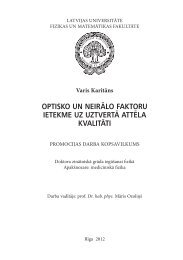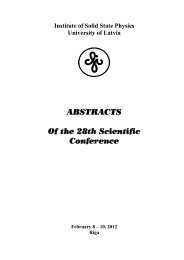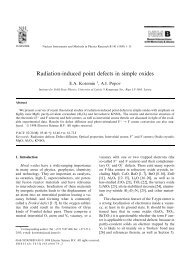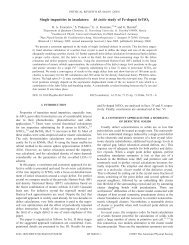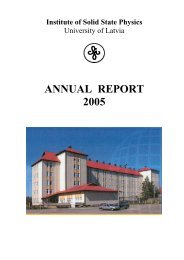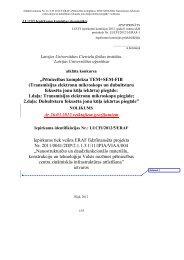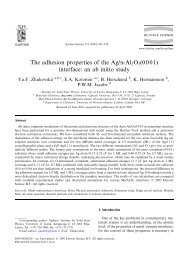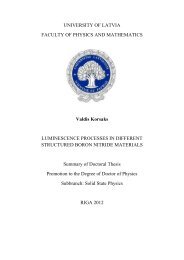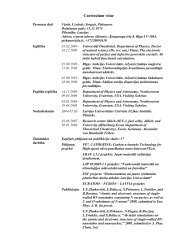Annual Report 2012 - Latvijas Universitātes Cietvielu fizikas institūts
Annual Report 2012 - Latvijas Universitātes Cietvielu fizikas institūts
Annual Report 2012 - Latvijas Universitātes Cietvielu fizikas institūts
You also want an ePaper? Increase the reach of your titles
YUMPU automatically turns print PDFs into web optimized ePapers that Google loves.
Main Results<br />
LASER CRYSTALLIZATION OF a-Si:H FOR SOLAR CELL APPLICATIONS<br />
G. Marcins, J. Butikova, J. Pervenecka, B. Polyakov, A. Muhin, I. Tale<br />
Manufacturing of thin film amorphous silicon solar cells has perspectives with a<br />
condition of improving solar cell efficiency and reducing production costs. Efficiency of<br />
amorphous silicon solar cells decreases with time due to<br />
formation of metastable light-induced defects. Laser<br />
crystallization helps to prevent this effect. We apply<br />
visible laser wavelength for laser crystallization in<br />
contrast to widely used exciton laser crystallization,<br />
which able to process only ~100 nm thick a-silicon layer.<br />
Primary effects of laser crystallization of a-silicon are<br />
dopants activation, and increase of charge carrier<br />
mobility due to higher crystallinity of processed silicon.<br />
Additional effect is texturing of initially smooth surface, which decreases back reflection<br />
of incident light and increases efficiency of a solar cell.<br />
Amorphous silicon crystallization by laser beam of<br />
visible wavelength opens additional possibilities to<br />
process the whole p-i-n structure of thin film solar cell<br />
I-V curves of amorphous and laser processed<br />
a-Si:H solar cells.<br />
simultaneously. A-Si:H p-i-n thin film solar cell was grown by PECVD on ITO-coated<br />
glass substrates. Laser crystallization was successfully applied for processing the whole<br />
p-i-n structure of total thickness around 300 nm. A significant improvement of solar cell<br />
output parameters in comparison to a non-processed cell was achieved.<br />
GRAPHENE STAMP PRINTING<br />
J. Butikova, B. Polyakov, E. Butanovs, L. Dimitrocenko, I. Tale<br />
Graphene as a single monolayer of covalently bonded carbon atoms is an<br />
intriguing material for both fundamental and applied science. Due to its outstanding<br />
electronic and thermal properties (high charge carrier mobility, high heat conductance,<br />
etc.) graphene raised huge interest in the last decade, and became a real candidate as a<br />
successor of silicon in future microelectronics. There is plenty of graphene synthesis<br />
methods, however, the best electric properties were demonstrated by graphene<br />
mechanically cleaved from HOPG. Cleaved HOPG graphene sheets, nevertheless, are<br />
usually irregular in shape and thickness, and therefore are not suitable for integration in<br />
microelectronics devices.<br />
Highly oriented pyrolytic graphite (HOPG) was scribed by the pulsed laser beam<br />
to produce square patterns. Patterning of HOPG surface facilitates the detachment of<br />
graphene layers during contact printing. Direct HOPG-to-substrate and glue-assisted<br />
stamp printing of a few-layers graphene was compared. Printed graphene sheets were<br />
visualized by optical and scanning electron microscopy. The number of graphene layers<br />
was measured by atomic force microscopy. Glue-assisted stamp printing allows printing<br />
relatively large graphene sheets (40×40 μm) onto a silicon wafer. The presented method<br />
is easier to implement and is more flexible than the majority of existing ways of placing<br />
graphene sheets onto a substrate.<br />
23





